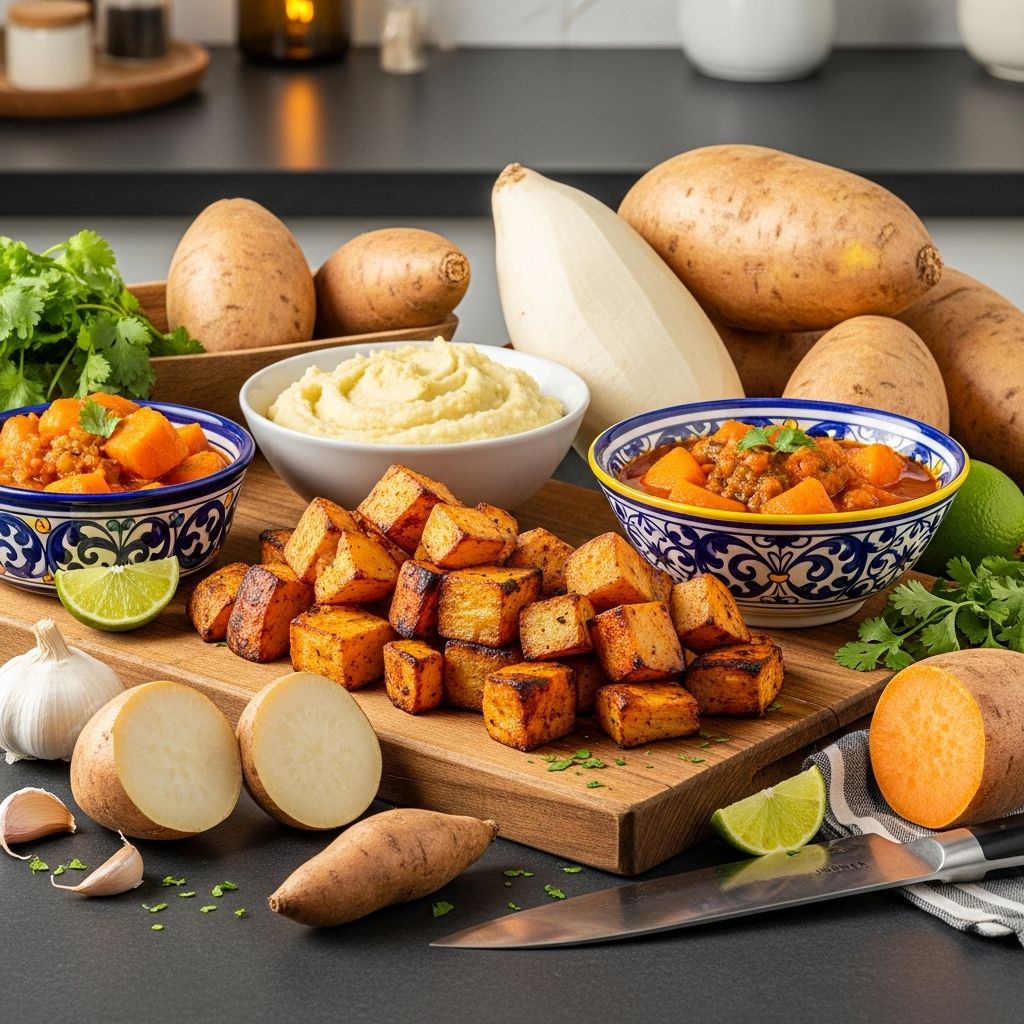Best Boniato (Cuban Sweet Potato) Recipes & Cooking Tips
Discover the Delight of Boniato: Recipes and Perfect Cooking Techniques

Introduction to Boniato
Boniato, often referred to as the Cuban sweet potato, is a staple in many Latin American cuisines. It is particularly popular in Cuba, where it is used in a variety of dishes, from sweet desserts like Boniatillo Con Coco to savory delights such as Cuban-Style Boniato Frito. Boniato’s unique characteristics make it a favorite among chefs and home cooks alike. It has a drier texture and a nuttier flavor compared to the common orange-fleshed sweet potatoes found in the U.S.
What is Boniato?
Boniato is a type of sweet potato that is readily available in Latin and Asian markets. It is characterized by its white flesh and reddish-brown skin. The word “boniato” is Spanish for “sweet potato,” but it specifically refers to this variety, which is distinct from the sweet potatoes commonly consumed in North America.
How to Choose Boniato
Choosing the right boniato is crucial for achieving the best results in your recipes. Here are some tips:- Look for Firmness: Opt for boniatos that are firm and have smooth skin free of blemishes.- Color and Texture: The skin should have a red-ish brown hue, and the boniato should feel heavier than a regular sweet potato.- Storage: Store boniatos in a cool, dry place to keep them fresh for longer.
Cooking Boniato: Tips and Techniques
Cooking boniato requires attention to detail to bring out its unique texture and flavor. Here are some tips for cooking boniato perfectly:- Boiling: Boil boniato until it is tender. This can be achieved by simmering it in water for about 30 minutes.- Baking: Boniato can also be baked in the oven. Preheat your oven to 400°F (200°C) and bake for about 45 minutes, or until tender.- Frying: For a crispy exterior, slice the boniato thinly and fry in coconut oil until golden brown.
Best Boniato Recipes
1. Boniatillo Con Coco (Cuban Sweet Potato Pudding)
Boniatillo Con Coco is a delicious dessert that combines the richness of sweet potatoes with the tropical flavor of coconut. It’s essentially a creamy sweet potato pie filling without the crust, infused with coconut milk and grated coconut. This dessert is a staple in Cuban cuisine, often served during special occasions like Noche Buena.
Ingredients:– 2 lbs boniatos (white-fleshed sweet potatoes)- 13.5 oz full-fat coconut milk- 1 cup granulated sugar- 2 cinnamon sticks- Pinch of salt- 1 cup grated coconut (strained from the can without syrup)
Instructions:1. Wash, peel, and cut the boniatos into 1-inch cubes.2. Boil the cubes until tender, then mash.3. In a skillet, combine coconut milk, sugar, and cinnamon sticks. Heat until the sugar dissolves.4. Add the mashed boniatos and cook until the mixture thickens like a porridge.5. Stir in grated coconut and cook for an additional few minutes.6. Chill before serving.
2. Cuban-Style Boniato Frito (Batatas)
This recipe is perfect for those looking for a crispy, savory snack. It follows a similar process to frying French fries but uses boniato instead. This dish is gluten-free, dairy-free, and suitable for Paleo and AIP diets.
Ingredients:– 2 large boniatos- 2 cups unrefined coconut oil- 1 teaspoon unrefined salt- 1 teaspoon granulated sweetener (optional)
Instructions:1. Peel and dice the boniatos into small pieces.2. Heat coconut oil in a heavy-bottomed pot until hot.3. Fry the boniato pieces until they are golden brown.4. Drain and toss with salt and sweetener (if using).5. Serve hot with your favorite dip.
3. Boniato Relleno (Stuffed Boniato)
A variation of the popular Cuban dish Papa Rellena, Boniato Relleno involves filling boniatos with a flavorful mixture, often including ground beef or chicken.
Ingredients:– 2 lbs boniatos- 1 lb ground meat (beef or chicken)- Cooking oil- Spices (e.g., oregano, cumin)
Instructions:1. Boil or bake the boniatos until tender.2. Scoop out some of the flesh to make space for the filling.3. Mix the ground meat with spices and herbs.4. Stuff each boniato with the meat mixture.5. Fry until golden brown or bake until heated through.
Storage and Reheating Tips
Once cooked, boniatos can be stored in the refrigerator for a few days or frozen for longer storage. Reheat cooked boniatos by microwaving or oven reheating. For frozen boniatos, thaw them overnight in the refrigerator before reheating.
Frequently Asked Questions (FAQs)
Q: What does boniato taste like?
A: Boniato has a drier texture and a slightly nutty flavor compared to the common sweet potatoes. It is less sweet and has a starchier feel.
Q: Where can I find boniato?
A: Boniato is typically found in Latin or Asian grocery stores. In places like Florida, it might be more widely available.
Q: Can I substitute boniato with regular sweet potatoes in recipes?
A: While you can substitute boniato with regular sweet potatoes, keep in mind that the texture and flavor will be slightly different. Boniato offers a unique nutty taste and a drier texture that may alter the overall character of the dish.
Q: How do I store boniato for longer periods?
A: Store boniatos in a cool, dry place. They can also be cooked and refrigerated for up to five days or frozen for up to three months.
Conclusion
Boniato is a versatile ingredient that can elevate a variety of recipes from sweet desserts to savory snacks. With its unique texture and flavor, it adds a delightful twist to traditional dishes. Whether you’re experimenting with new desserts like Boniatillo Con Coco or venturing into savory fritters, boniato is sure to become a favorite in your kitchen.
References
- https://asassyspoon.com/boniatillo-con-coco/
- https://thecuriouscoconut.com/blog/cuban-style-boniato-frito-batatas-paleo-aip-whole30
- https://www.youtube.com/watch?v=OFB-CDNrCiU
- https://www.jctropicals.us/blog/recipes/fried-boniato/
- https://www.ohmysimplemeals.com/cuban-sweet-potato-recipe/
- http://nathanscomida.blogspot.com/2009/02/boniato-con-mojo-cuban-white-sweet.html
- https://www.youtube.com/watch?v=UoO2lPP_4lQ
- https://thecharmofhome.blogspot.com/2012/07/cuban-style-roasted-sweet-potatoes.html
Read full bio of medha deb












